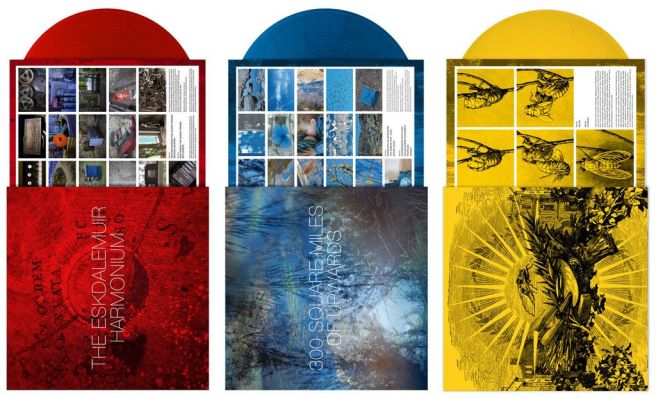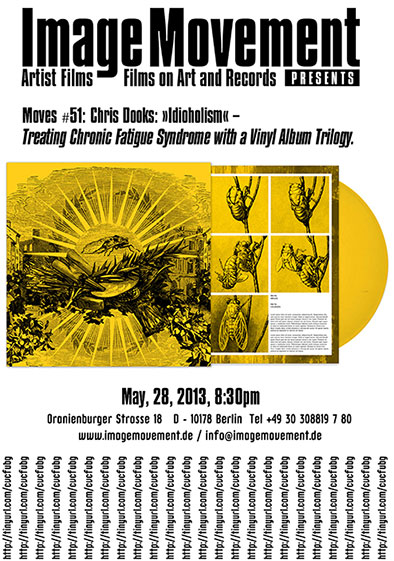Wherever medicine has discarded its caring role, or simply has no available cure, sufferers of chronic illnesses frequently turn to experimental and experiential strategies. Such strategies can seem an outlandish or surreal response to illness; for example, working closely with an abandoned and decrepit harmonium in the Scottish borders or forging Twitter-length statements about the universe may not be on the medical map, but to artists like myself, these processes are a way of life.
‘Idioholism’ is a term I created to describe my ‘medical humanities art practice’ and was/is the front-end of a suite of philosophical art projects I began to develop for my PhD, seven years ago. Through the PhD, I also attempted to evaluate whether ‘holism’ even exists as a viable, useful concept, hence the precaution of my creating the portmantaeu. I felt that the usefulness of the word ‘holistic’ had been usurped by the holistic healthcare industry into a meaningless trope.

Three records, three facets of life: The Idioholism Vinyl Trilogy 2009-2015
My motivation was ultimately to empower vulnerable or unwell individuals (of which I have counted myself) across the strata of their life, rather than see them as the complementary health industry frequently does, as a market or a cash-cow.
I’m not a theorist, but with a simple, specifically developed framework, I attempted to apply atypical techniques found in conceptual art and apply them to a healthcare context. Such areas included appropriation, field recording, phototherapy, psychogeography, bricolage – as part of a suite of methods, tools or resources to positively influence the illness trajectory of the participants.
So far, this has been practised only by myself in what may be termed an ‘autoethnographic’ experiment. The research is still ongoing and being refined.
The records you see below, in primary colours, are the ‘results’ of my five years of ‘idioholistic’ and reflexive modes of living, practised together, overlapping and immersing myself into deliberate listening, documentary, music composition, astronomical enquiry, in tiny, doable exercises that make life seem worth living. There are also many thousands of Cicadas featured in the trilogy. Bagpipes. Fireworks. And a woman in a farmhouse talks about the reason that you might fall in love with someone might be the reason you fall out of love with someone too.

There is one strict framework principle – and this is where it differs from art therapy – I would ‘triangulate‘ my own therapeutic solutions. This is why the records above are a trilogy and whilst they hopefully contain individual exercises worth sharing, they are more powerfully useful together. Whilst the loss of life experiences under illness cannot be easily regained, it is my odd experience that if three radically different pursuits are practiced concurrently, not only would I maximise the chances of bumping into something meaningful eventually, but patterns and contrasts would appear in the other facets of the practice.
I would pursue, over a week, three seemingly different practices which would almost form an art-school syllabus, but a very small scale and relaxed practical mode of study, in what I’ve termed a ‘proto-syllabus’. This is my idioholism. Someone else’s idioholism would be completely different but there would still remain three ‘chunks’ of enquiry.
Where people’s ‘idioholisms’ would be the same, would be in parts of the methodology, even if the content of these ‘thirds’ is different. The framework, and it’s a loose framework, remains the same. By combining sensual practices with the intellectual – and perhaps by adding a third element of ‘existential’ projects (or ‘spiritual’ for those inclined as such), we create a ‘triangular praxis’ of an art therapy where experimentation and self-awareness guide the activities chosen. It’s a case of trusting the triangle, the most stable shape, allowing for a little internal madness and chaos.
A typical week: On Mondays I would drive down to Eskdalemuir, near a Buddhist temple and record a wheezing harmonium. On Wednesdays I’d place field recorders on the windowsills of my house and leave them running for eight hours from 3am to catch the dawn chorus or not and on Fridays I’d study whether facts about the universe could be remembered if they were in song form, and start to build my own.
The launch of the first record was in 2013 in Berlin with Andreas Reihse of the band Kreidler at www.image-movement.de with subsequent launches at the Centre for Contemporary Arts in Glasgow, Scotland and at Woodend Barn in Banchory, Scotland.
(c) Dr Chris Dooks, Edinburgh 2017

